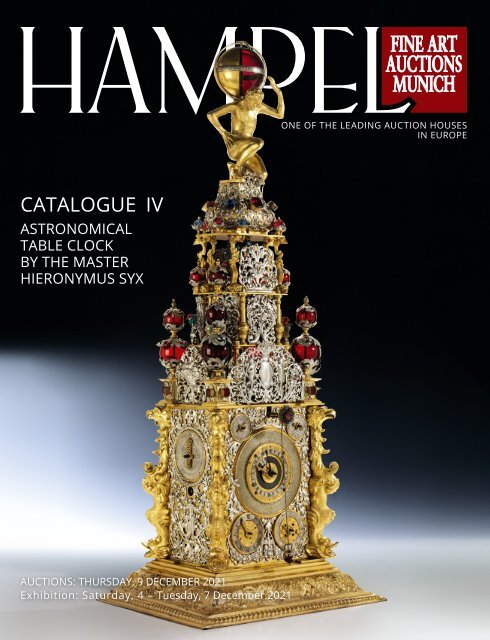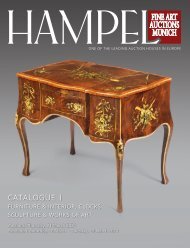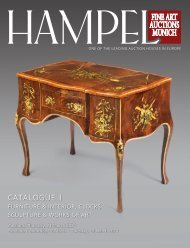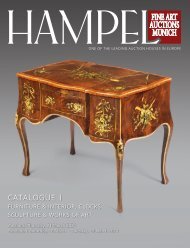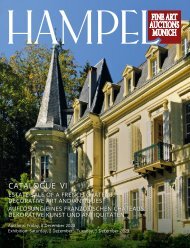Sie wollen auch ein ePaper? Erhöhen Sie die Reichweite Ihrer Titel.
YUMPU macht aus Druck-PDFs automatisch weboptimierte ePaper, die Google liebt.
ONE OF THE LEADING AUCTION HOUSES<br />
IN EUROPE<br />
CATALOGUE IV<br />
ASTRONOMICAL<br />
TABLE CLOCK<br />
BY THE MASTER<br />
HIERONYMUS SYX<br />
AUCTIONS: THURSDAY, 9 DECEMBER 2021<br />
Exhibition: Saturday, 4 – Tuesday, 7 December 2021
LOT 455<br />
EIN SÜDDEUTSCHES<br />
MEISTERSTÜCK DES<br />
AUGSBURGER BAROCK<br />
EINE SEHR GROSSE ASTRONOMISCHE TISCHUHR<br />
DES MEISTERS HIERONYMUS SYX (1680 – 1726)<br />
VERGOLDET, SILBER UND SELTENES KUNCKEL-<br />
GOLDRUBINGLAS<br />
A SOUTH GERMAN MASTERPIECE<br />
TABLE CLOCK OF THE AUGSBURG<br />
BAROQUE PERIOD<br />
A VERY LARGE ASTRONOMICAL TABLE CLOCK BY<br />
MASTER HIERONYMUS SYX (1680 – 1726) WITH<br />
GILT-BRASS, SILVER AND RARE KUNCKEL RUBY GLASS<br />
Translate all texts into your preferred language on our homepage via Google: www.hampel-auctions.com<br />
13
455<br />
EIN SÜDDEUTSCHES MEISTERSTÜCK DES<br />
AUGSBURGER BAROCK<br />
EINE SEHR GROSSE ASTRONOMISCHE TISCHUHR<br />
DES MEISTERS HIERONYMUS SYX (1680 – 1726)<br />
MIT VERGOLDETEM MESSING, SILBER UND<br />
SELTENEM KUNCKEL- GOLDRUBINGLAS<br />
78,7 x 32,4 x 26,4 cm.<br />
Signiert auf beiden Platinen „Hyeronimus <strong>Syx</strong> /<br />
Augustae Vindelicorum“ und mit Augsburger<br />
Pyr-Marken (Zirbelnuss). <strong>Hieronymus</strong> <strong>Syx</strong> (1680 –<br />
1726, Meister ab 1705).<br />
Augsburg, 1705. (†)<br />
Das Gehäuse:<br />
Allseits mit Kunckel-Goldrubinglas verziert. Der als<br />
Be krönung fungierende kniende Atlas trägt eine Weltkugel<br />
mit eingraviertem Band, auf welchem die Mondphasen<br />
angezeigt werden. Darunter eine vierstufige<br />
konisch zulaufende Struktur mit innenliegendem<br />
Glockenwerk, wobei je<strong>des</strong> Element mit repoussiertem,<br />
silbernem Blattornament, flankiert von blattgekrönten<br />
Kugeln in Kunckel-Stein und blauen Glaselementen<br />
um die stilisierten Delfin- und Balustersäulen à jour<br />
gearbeitet ist. Das rechteckige Gehäuse mit weiteren<br />
silbernen Blattwerkbeschlägen und Ecklisenen mit vergoldeten<br />
und fein ziselierten Adler- und Delfinköpfen,<br />
auf einem abgestuften, sich nach unten verbreiternden<br />
Sockel mit godroniertem Rand. Abnehmbare Seitenteile.<br />
A SOUTH GERMAN MASTERPIECE TABLE CLOCK<br />
OF THE AUGSBURG BAROQUE PERIOD<br />
A VERY LARGE ASTRONOMICAL TABLE CLOCK BY<br />
MASTER HIERONYMUS SYX (1680 – 1726) WITH<br />
GILT-BRASS, SILVER AND RARE KUNCKEL GLASS<br />
78.7 x 32.4 x 26.4 cm.<br />
Signed on both plates “Hyeronimus <strong>Syx</strong> / Augustae<br />
Vindelicorum“ and with pyr marks for Augsburg<br />
(cembra nut). <strong>Hieronymus</strong> <strong>Syx</strong> (1680 – 1726, master<br />
since 1705).<br />
Augsburg, 1705. (†)<br />
The case:<br />
Embellished on all si<strong>des</strong> with Gold Ruby glass by<br />
Kunckel (also known as Cranberry glass). A kneeling<br />
finial figure of Atlas supporting a globe with an engraved<br />
band indicating the phases of the moon, surmounts<br />
the clock. In turn, he surmounts a four-tiered<br />
conical structure enclosing an internal bell mechanism,<br />
whereby each element is decorated with repoussé<br />
silver foliate ornament flanked by Kunckel<br />
glass spheres decorated with foliage décor and blue<br />
glass elements, which are surrounded by stylized dolphin<br />
and baluster columns. The rectangular case with<br />
further silver foliate mounts and corner pilasters with<br />
gilt and finely chased eagle and dolphin heads, on a<br />
stepped plinth that widens towards the bottom with<br />
a gadrooned border. Detachable side panels.<br />
16 HAMPEL ONLINE Visit www.hampel-auctions.com for around 6,500 additional images.
Das Hauptzifferblatt:<br />
Die drei inneren Ringe für die variablen italienischen<br />
und babylonischen Stunden, jeweils mit der Gravur<br />
„1-24“, ein versilberter doppelter 12-Stunden-Ring in<br />
römischen schwarzen Ziffern mit äußerem Viertelstunden-Ring,<br />
der mit „I-IIII“ unterteilt ist. Mit arabischen<br />
Fünf-Minuten-Markierungen, der umkehrbare äußere<br />
Kalenderring, der auf jeder Seite sechs Monate eingraviert<br />
hat und die Monate, Monatstage und die entsprechenden<br />
Heiligentage zusammen mit Dominizalbuchstaben<br />
zeigt.<br />
Die Hilfszifferblätter:<br />
Oben links mit der Goldenen Zahl „Cyclus Aurei<br />
Numeri“ mit den Ziffern „1-19“; oben rechts für den<br />
Anzeigezyklus „Cyclus Idictionum“ mit den Ziffern „1-<br />
15“; unten links für die Einstellung <strong>des</strong> Weckers; unten<br />
rechts mit dem Tierkreiskalender, eingraviert mit<br />
den entsprechenden Symbolen für die Monate, für die<br />
Einstellung <strong>des</strong> Breitengra<strong>des</strong> für die variablen Stunden<br />
mit den Ziffern „12-19“.<br />
The main dial:<br />
The three inner rings for variable Italian and Babylonian<br />
hours, each with engraved numbers “1-24“, a<br />
silvered twice 12-hour ring in black Roman numerals<br />
with an outer quarter hour ring divided into “I-IIII“.<br />
Furthermore, Arabic five minute markers, the reversible<br />
outer calendar ring engraved with six months to<br />
each side, showing months, days of the month and<br />
the corresponding Saints days together with dominical<br />
letters.<br />
The subsidiary dials:<br />
Upper left with gilt number “Cyclus Aurei Numeri“<br />
numbered “1-19“; upper right for Cycle of Indication<br />
“Cyclus Idictionum“ numbered “1-15“; lower left for<br />
alarm setting; lower right with the Zodiacal calendar,<br />
engraved with the corresponding symbols for the<br />
months, for setting the latitude for the variable hours<br />
numbered “12-19“.<br />
18 HAMPEL ONLINE Visit www.hampel-auctions.com for around 6,500 additional images.
Die astronomische <strong>Tischuhr</strong> ist allseits<br />
mit Kunckel-Goldrubinglas verziert.<br />
Der als Bekrönung fungierende kniende<br />
Atlas trägt eine Weltkugel mit eingraviertem<br />
Band, auf welchem die<br />
Mondphasen angezeigt werden.
Das rechteckige Gehäuse mit weiteren<br />
silbernen Blattwerkbeschlägen und<br />
Eck lisenen mit vergoldeten und fein<br />
ziselierten Adler- und Delfinköpfen, auf<br />
einem abgestuften, sich nach unten<br />
verbreiternden Sockel.
Abbildungen der <strong>Tischuhr</strong> finden sich unter anderem in folgender Literatur:<br />
Illustrations of the table clock are to be found in the following literature:<br />
The Glory of the Goldsmith. Magnificent Gold and<br />
silver from the Al-Tajir Collection, Christie‘s, London<br />
1989, S. 274-275.<br />
22 HAMPEL ONLINE Visit www.hampel-auctions.com for around 6,500 additional images.
Klaus Maurice, Die Deutsche Räderuhr, Band I & II,<br />
München 1976, S. 42-43, Tafel 247.<br />
Abbildungen der Uhr auf der rechten Seite der Bücher.<br />
Illustration of the clock on the right side of the books.<br />
Translate all texts into your preferred language on our homepage via Google: www.hampel-auctions.com<br />
23
Schräg-seitliche Ansichten der Uhr<br />
mit Hauptzifferblatt, Hilfszifferblättern<br />
und dem Zifferblatt <strong>des</strong> Astrolabiums
Darstellung der<br />
abnehmbaren Seitenteile
Weitere Darstellung der<br />
abnehmbaren Seitenteile
Die Entfernung aller<br />
Seitenteile der Uhr
Das Zifferblatt <strong>des</strong> Astrolabiums:<br />
Die Breitengradplatte mit stereografischen Projektionen,<br />
eingraviert „Tropicus Capricorni“, „Circulus<br />
Equi no ctalis“ und „Tropicus Cancri“, die fein gravierte<br />
Rete mit Zeigern für 15 Sterne („Crus Aquary“, „Venter<br />
Ceti“, „Piostrum Ceti“, „Oculus Jaury“, „Canis Major“,<br />
„Canis Minor“, „Lucida Hydra“, „Car Leonis“, „Spica<br />
Virginis“, „Cauda“, „Sinister Serpentary“, „Corona Septentrionalis“,<br />
„Caput Antinoj“, „Caput Serpentarii“ und<br />
„Crus Pegasi“), und mit den Größenordnungen (1-3),<br />
der Elliptik mit den Tierkreiseinteilungen und -symbolen,<br />
dem doppelendigen Lineal, das gegen die Rete zeigt,<br />
wobei ein Ende die Tagesstunden anzeigt, das andere<br />
mit dem Sonnengesicht graviert ist und die Position<br />
der Sonne im Tierkreis während <strong>des</strong> Jahres anzeigt,<br />
dem Aspektdiagramm zur zentralen Scheibe und den<br />
Phasen und dem Alter <strong>des</strong> Mon<strong>des</strong>, der durch eine<br />
Öffnung betrachtet wird, die von einem doppelten<br />
12-Stunden-Ring umgeben ist.<br />
Die Hilfszifferblätter:<br />
Oben links für „12“- oder „24“- Stundenschlag; oben<br />
rechts für Schlag / Stille „Schlägt / Schlägt nit“; unten<br />
links mit den dominischen Buchstaben; unten rechts<br />
mit den Planetentagen „Sool“ (Sonntag), „Luna“<br />
(Mon tag), „Mars“ (Dienstag), „Merc“ (Mittwoch), „Jupiter“<br />
(Donnerstag), „Venus“ (Freitag) und „Saturn“<br />
(Samstag). Die linke Seite <strong>des</strong> Gehäuses mit den Angaben<br />
für den Viertelstundenschlag „1-4“, die rechte<br />
Seite mit den Angaben für den 12- oder 24-Stundenschlag.<br />
The astrolabe dial:<br />
The latitude plate with stereographic projections,<br />
engraved “Tropicus Capricorni“, “Circulus Equinoctalis“<br />
and “Tropicus Cancri“, the finely engraved rete with<br />
pointers for 15 stars (“Crus Aquary“, “Venter Ceti“,<br />
“Piostrum Ceti“, “Oculus Jaury“, “Canis Major“, “Canis<br />
Minor“, “Lucida Hydra“, “Car Leonis“, “Spica Virginis“,<br />
“Cauda“, “Sinister Serpentary“, “Corona Septentrionalis“,<br />
“Caput Antinoj“, “Caput Serpentarii“ and “Crus<br />
Pegasi“), and showing orders of magnitude (1-3), the<br />
elliptic with the zodiacal divisions and symbols, the<br />
double-ended rule indicating against the rete with<br />
one end indicating the hours of the day, the other engraved<br />
with sun face and indicating the position of<br />
the sun through the Zodiac throughout the year, aspect<br />
diagram to central disc and phases and age of<br />
the moon viewed through an aperture, enclosed by a<br />
twice 12-hour ring.<br />
The subsidiary dials:<br />
Upper left for “12“ or “24“ hour striking; upper right<br />
for strike / silent “Schlägt / Schlägt nit“; lower left<br />
showing Dominical Letters; lower right with planetary<br />
days of the week “Sool“ (Sunday), “Luna“ (Monday),<br />
“Mars“ (Tuesday), “Merc“ (Wednesday), “Jupiter“<br />
(Thursday), “Venus“ (Friday) and “Saturn“ (Saturday).<br />
The left-hand side of the case with indicators for quarter<br />
striking “1-4“, the right-hand side with 12- or 24<br />
hour-striking indications.<br />
32 HAMPEL ONLINE Visit www.hampel-auctions.com for around 6,500 additional images.
Die Seitenansicht mit dem Pendel<br />
und seinem Goldrubin-Abschluss<br />
mit Silberfassung
Die Geschichte <strong>des</strong> Handwerks in Augsburg reicht bis<br />
ins 14. Jahrhundert zurück, als die Uhrmacher Teil einer<br />
1368 gegründeten größeren Zunft allgemeiner Schmiede<br />
waren. Die Uhrmacher wurden 1564 autonom, sodass<br />
sie ihr Handwerk selbst verwalten konnten.<br />
Um Meister zu werden, musste ein Uhrmacher eine<br />
dreijährige Lehre absolvieren und eine ähnliche Zeit<br />
lang bei verschiedenen Meistern als Geselle arbeiten.<br />
Erst dann konnte er sich als Uhrmachermeister bewerben,<br />
indem er seine Fähigkeiten und Fertigkeiten bei<br />
der Herstellung einer Meisteruhr unter Beweis stellte.<br />
Die Augsburger Uhrmacherinnung legte fest, dass eine<br />
Meisteruhr die folgenden Anforderungen erfüllen<br />
musste:<br />
Eine Uhr mit denselben Maßen wie bisher, etwa eine<br />
Spannweite hoch, die die Stunden und Viertelstunden<br />
schlägt. Sie soll auch einen Wecker haben und auch<br />
das Astrolabium, die Länge der Tage, den Kalender<br />
und die Planeten und ihre Symbole anzeigen. Wenn<br />
der Viertelstundenzeiger bewegt wird, bewegen sich<br />
alle Zeiger im Gleichschritt mit ihm, und außerdem<br />
schlägt die Uhr die Stunden sowohl auf 12 als auch auf<br />
24, je nach Wahl (siehe Klaus Maurice und Otto Mayr<br />
(Hrsg.), The Clockwork Universe. German Clocks and<br />
Automata 1550-1650, München 1980, S. 67). Wie alle<br />
Uhren, die seinerzeit als <strong>Meisters</strong>tücke gefertigt wurden,<br />
wurde auch diese Uhr in einem Zeitraum von nur<br />
sechs Monaten hergestellt. Als sie 1705 fertiggestellt<br />
wurde, waren die Statuten der Zunft von 1577 noch in<br />
Kraft. Diese waren in den dazwischenliegenden 128<br />
Jahren unverändert geblieben, was das traditionelle<br />
Turmformat dieser Uhr erklärt. Augsburg ist für die<br />
Qualität seiner Uhren bekannt, und diese Uhr verkörpert<br />
dieses hohe handwerkliche Niveau zusammen<br />
mit der Zusammenarbeit mit anderen Facharbeitern<br />
wie den Goldschmieden, Kupferschmie den und Messinggießern.<br />
Letztere waren 1588 streng auf sieben<br />
Meister beschränkt, die zudem nur für Uhrmacher<br />
gießen durften. Elemente wie die Delfinbeschläge an<br />
den Winkeln der vorliegenden Uhr wurden in großer<br />
Zahl hergestellt und wiederholen sich häufig auf bekannten<br />
Uhren; so hat beispielsweise die Meisteruhr<br />
aus der ehemaligen Sammlung Ilbert, die sich jetzt im<br />
British Museum befindet (British Museum, Inv.Nr.<br />
CAI-2129) ihre Beschläge mit der Meisteruhr von Johan<br />
Hasse (Christie‘s, London, 5. Dezember 1995, Lot 83)<br />
und einer anderen Augsburger Uhr aus dieser Zeit, die<br />
sich früher in Münster befand (Maurice, Op. Cit., Tafel<br />
248), gemeinsam. Die vorliegende Uhr ist mit der<br />
Augsburger Punze, der Zirbelnuss (Pyr), auf jeder Platine<br />
<strong>des</strong> Uhrwerks gekennzeichnet.<br />
The history of the craft in Augsburg dates back to the<br />
14th century, when the clockmakers were part of a<br />
larger guild of general blacksmiths founded in 1368.<br />
Clockmakers became autonomous in 1564, enabling<br />
them to manage their craft themselves.<br />
To become a master, a clockmaker had to complete a<br />
three-year apprenticeship and work as a journeyman<br />
with various masters for a similar period of time. Only<br />
then could he apply to become a master clockmaker<br />
by proving his skills and abilities in the manufacture<br />
of a master clock. The Augsburg Clockmakers Guild<br />
stipulated that a master clock had to meet the following<br />
requirements:<br />
A clock with the same dimensions as before, about a<br />
span high that strikes the hours and quarters of an<br />
hour. It is also had to have an alarm clock and had to<br />
display the astrolabe, the length of the days, the calendar<br />
and the planets and their symbols. When the<br />
quarter-hour hand is moved, all hands move in step<br />
with it, and the clock also strikes the hours on both<br />
12 and 24, depending on your choice (see Klaus Maurice<br />
and Otto Mayr (ed.), The Clockwork Universe.<br />
German Clocks and Automata 1550 - 1650, Munich<br />
1980, p. 67). Like all clocks that were made as masterpieces<br />
at the time, this clock was also made in a<br />
period of just six months. When it was completed in<br />
1705, the guild‘s statutes from 1577 were still in<br />
force. These remained unchanged in the intervening<br />
128 years, which explains the traditional tower format<br />
of this clock. Augsburg is known for the quality of its<br />
clocks, and this clock embodies this high level of<br />
craftsmanship together with the collaboration with<br />
other skilled workers such as goldsmiths, coppersmiths<br />
and brass foundries. The latter were strictly<br />
limited to seven masters in 1588, who were also<br />
only allowed to cast for clockmakers. Elements such<br />
as the dolphin fittings on the corners of this clock<br />
were produced in large numbers and are often repeated<br />
on known clocks; For example, the master<br />
clock from the former Ilbert collection, which is now<br />
held at the British Museum (British Museum, inv. no.<br />
CAI-2129), has its fittings with the master clock by<br />
Johan Hasse (Christie‘s, London, December 5, 1995,<br />
lot 83) and another Augsburg clock from this period,<br />
which was previously in Münster (Maurice, Op.<br />
Cit., plate 248). The present clock is marked with the<br />
Augs burg hallmark, the stone pine (pyr), on each<br />
plate of the movement.<br />
36 HAMPEL ONLINE Visit www.hampel-auctions.com for around 6,500 additional images.
Das Werk:<br />
Das quadratische Rahmenwerk aus vergoldetem<br />
Mes sing steht auf gedrechselten Säulen über dem<br />
Sockel, signiert auf beiden Platinen „Hyeronimus<br />
<strong>Syx</strong> / Augustae Vindelicorum“ (vgl. Anmerkung 2) und<br />
mit Augsburger Pyr-Marken (Zirbelnuss), mit gebläuten<br />
Stahlakzenten und ornamentaler Gravur, dreikettiges<br />
Schneckenwerk und ein stehen<strong>des</strong> Federhaus für den<br />
Wecker, Spindelgang, Zählradschlag auf die Glocke<br />
und Viertelstundenschlag auf eine weitere Glocke,<br />
Pendel auf der Vorderseite; einige Zifferblätter offensichtlich<br />
nicht funktionstüchtig. (†)<br />
Provenienz:<br />
Lempertz, Zürich, 14.-17. November 1956, Lot 1333a.<br />
Sammlung M. W. L. Boon.<br />
Sammlung Mrs. Boon van Kol.<br />
Auktion, Sotheby Mak Van Waay B. V., Amsterdam,<br />
2. April 1981, Lot 264.<br />
The Al-Tajir Collection, von dort durch den Vorbesitzer<br />
erworben.<br />
Anmerkung 1:<br />
<strong>Hieronymus</strong> <strong>Syx</strong> (oder Six) (1680-1726), stellte diese<br />
Uhr 1705 nachweislich als sein <strong>Meisters</strong>tück fertig<br />
(siehe Klaus Maurice, Die Deutsche Räderuhr,<br />
Bd. I & II, München 1976, S. 42-43).<br />
The Movement:<br />
The gilt-brass square-section posted frame movement<br />
is raised above the base on turned pillars,<br />
signed to both end plates “Hyeronimus <strong>Syx</strong> / Augustae<br />
Vindelicorum“ (see note 2) and with Augsburg<br />
pine cone pyr marks, with blued-steel highlights<br />
and ornamental engraving, three-chain fusee movement<br />
and a standing barrel for the alarm, verge escapement,<br />
count wheel strike on bell and quarter<br />
strike on further bell, front-swinging pendulum; some<br />
dials apparently non-functioning. (†)<br />
Provenance:<br />
Lempertz, Zurich, 14-17 November 1956, lot 1333a.<br />
Collection of Mrs. Boon van Kol.<br />
Auction, Sotheby Mak Van Waay B. V., Amsterdam,<br />
2 April 1981, lot 264.<br />
The Al-Tajir Collection, until acquired by previous<br />
owner.<br />
Notes 1:<br />
<strong>Hieronymus</strong> <strong>Syx</strong> (or Six) (1680-1726), verifiably<br />
completed this clock as his masterpiece in 1705<br />
(see Klaus Maurice, Die Deutsche Räderuhr,<br />
vol. I & II, Munich 1976, pp. 42-43).<br />
42 HAMPEL ONLINE Visit www.hampel-auctions.com for around 6,500 additional images.
Anmerkung 2:<br />
Johannes Kunckel (um 1630-1703) begann 1679 unter<br />
dem Großen Kurfürst in Potsdam mit der Produktion<br />
von Kristallglas, und Kunckel war es, der die Produktion<br />
von Goldrubinglas technisch so weiterentwickelte,<br />
dass eine Produktion auch für den Export möglich war.<br />
Neben Goldrubinglas entwickelte Kunckel auch weitere<br />
Farbgläser durch die Zumischung von Metalloxiden.<br />
Anmerkung 3:<br />
Augusta Vindelicorum: der Beiname Vindelicorum<br />
leitet sich von dem keltischen Volksstamm der Vindeliker<br />
ab, der in einem Teil der Provinz Raetia zwischen<br />
Wertach und Lech siedelte. Die Namensform im<br />
Genitiv Plural „Vindelicorum“ ist so erst ab dem 16.<br />
Jahrhundert belegbar, zuvor „Augusta Vindelicum“<br />
Literatur:<br />
Die hier angebotene Uhr wird in folgender Literatur<br />
aufgeführt:<br />
Klaus Maurice, Die Deutsche Räderuhr, Bd. I & II,<br />
München 1976, S. 42-43, Tafel 247.<br />
Jürgen Abeler, Meister der Uhrmacherkunst,<br />
Wupper tal 1977, S. 587.<br />
Clocks, Juni 1981, S. 26-31.<br />
The Glory of the Goldsmith. Magnificent Gold and<br />
Silver from the Al-Tajir Collection, Christie‘s, London<br />
1989, S. 274-275.<br />
Vgl. Klaus Maurice und Otto Mayr (Hrsg.), The Clockwork<br />
Universe. German Clocks and Automata 1550-<br />
1650, Washington D.C. 1980.<br />
Vgl. Laurie Winters, A Renaissance Treasury. The Flagg<br />
collection of European decorative arts and sculpture,<br />
New York 1999.<br />
Vgl. David Thompson, Clocks, London 2004.<br />
Vgl. Lothar Kuhnert, Johann Kunckel. Ritter von Löwenstern.<br />
Die Erfindung der Nanotechnologie in Berlin,<br />
Berlin 2008.<br />
Vgl. H. Günter Rau, Das Glaslaboratorium Johann<br />
Kunckels auf der Pfaueninsel, in: Ausgrabungen in<br />
Berlin, Bd. 3, 1972, S. 148-171.<br />
Ausstellung:<br />
Christie‘s, London, The Glory of the Goldsmith, 3.-22.<br />
Januar 1990, Lot 240. (†)<br />
Note 2:<br />
Johannes Kunckel (ca. 1630-1703) began producing<br />
crystal glass under the Great Elector in Potsdam in<br />
1679, and it was Kunckel who technically advanced<br />
the production of Gold Ruby or Cranberry glass so<br />
that production was also possible for export. Kunckel<br />
also developed other coloured glass by adding metal<br />
oxi<strong>des</strong>.<br />
Note 3:<br />
Augusta Vindelicorum; the epithet Vindelicorum is<br />
derived from the Celtic vocative tribe of the Vindelics,<br />
who settled in a part of the province of Raetia between<br />
Wertach and Lech. “Vindelicorum“, the genitive plural<br />
form of the name is only attested from the 16th<br />
century onwards, previously known is “Augusta Vindelicum“.<br />
Literature:<br />
The clock offered here is listed in the following literature:<br />
Klaus Maurice, Die Deutsche Räderuhr, vol. I & II,<br />
Munich 1976, pp. 42-43, plate 247.<br />
Jürgen Abeler, Meister der Uhrmacherkunst,<br />
Wuppertal 1977, p. 587.<br />
Clocks, June 1981, pp. 26-31.<br />
The Glory of the Goldsmith. Magnificent Gold and<br />
Silver from the Al-Tajir Collection, Christie‘s, London<br />
1989, pp. 274-275.<br />
cf. Klaus Maurice and Otto Mayr (ed.), The Clockwork<br />
Universe. German Clocks and Automata 1550 - 1650,<br />
Washington D.C 1980.<br />
cf. Laurie Winters, A Renaissance Treasury. The Flagg<br />
collection of European decorative arts and sculpture,<br />
New York 1999.<br />
cf. David Thompson, Clocks, London 2004.<br />
cf. Lothar Kuhnert, Johann Kunckel. Ritter von Löwenstern.<br />
Die Erfindung der Nanotechnologie in Berlin,<br />
Berlin 2008.<br />
cf. H. Günter Rau, Das Glaslaboratorium Johann<br />
Kunckels auf der Pfaueninsel, in: Ausgrabungen<br />
in Berlin, vol. 3, 1972, pp. 148-171.<br />
Exhibitions:<br />
Christie‘s, London, The Glory of the Goldsmith, 3 - 22<br />
January 1990, lot 240. (†)<br />
€ 450.000 - € 550.000<br />
Sistrix<br />
INFO | BIETEN<br />
Translate all texts into your preferred language on our homepage via Google: www.hampel-auctions.com<br />
45
Johannes Kunckel‘s<br />
Ruby Glass:<br />
The alchemist Johannes Kunckel was commissioned<br />
by Elector Frederick William to produce gold.<br />
The result, however, was ruby-red glass that was<br />
henceforth called Kunckel glass. Johannes Kunckel<br />
von Löwenstern was born in Hütten near Rendsburg<br />
(Schleswig) in 1630 as the son of a chemist. He<br />
was first instructed in the natural sciences by his father.<br />
Frederick William, also known as “the Great Elector”,<br />
hoped that the experienced chemist and alchemist<br />
would give him new impulses for the economic development<br />
of his country, because Kunckel had researched<br />
phosphorus and, with “Ars Vitraria Experimentalis<br />
or Vollkommene Glasmacher-Kunst” (The<br />
Art of Perfect Glassmaking), he had written a standard<br />
book on glassmaking.<br />
After his apprenticeship, Johannes Kunckel was hired<br />
by the Court of Saxony to produce gold for the Elector.<br />
However, the Elector owed him his salary for<br />
months. The reason: if Kunckel could really make<br />
gold, then he would not need any payment, and if he<br />
could not, then he would not be worth any payment<br />
either. In 1678 Johannes Kunckel followed the call of<br />
the Brandenburg Elector Frederick William to Berlin,<br />
where he was hired as a secret chamberlain for an<br />
annual salary of 500 thalers.<br />
46 HAMPEL ONLINE Visit www.hampel-auctions.com for around 6,500 additional images.
The Elector had already promoted Brandenburg glass<br />
production, which could rely on local raw materials,<br />
and supported it with import bans. But now, with<br />
Kunckel’s assistance, he intended to produce highquality<br />
glass for export. Until then only one of four<br />
electoral glassworks, “Drewitzer Hütte“, had managed<br />
to produce high-quality crystal glass. Kunckel took<br />
over these glassworks in 1678 and opened another in<br />
Potsdam a year later. Among other things he produced<br />
so-called corals there: coloured, but worthless<br />
glass beads that the Guinea Company in the Brandenburg<br />
colonies of Africa traded for valuable goods,<br />
that were coveted in Europe.<br />
Thanks to his experiments, Kunckel decisively refined<br />
the so-called ruby glass and managed to produce it in<br />
larger quantities. Products made from this precious<br />
glass, whose colour resembles that of the ruby<br />
gemstone, were soon in demand as luxury items<br />
and ideally suited for export too.<br />
Kunckel worked under the protection of the elector<br />
in Berlin and Potsdam for ten years. In 1685, the<br />
Great Elector even gave him a small island in the<br />
Havel, today’s Pfaueninsel, where he could continue<br />
to experiment in his own laboratory undisturbed. After<br />
the death of his patron in 1688, however, Kunckel<br />
fell out of favour at the Brandenburg court. He left<br />
Berlin and took up a job as a mine manager with the<br />
Swedish King Charles XI. Here, he enjoyed a high<br />
reputation as an exceptional scientist for many years<br />
and was even ennobled.<br />
In 1703 Kunckel died in Bernau near Berlin. Like all<br />
other alchemists, he had never succeeded in producing<br />
gold. But ruby glass is inextricably linked to his<br />
name to this day.<br />
48 HAMPEL ONLINE Visit www.hampel-auctions.com for around 6,500 additional images.
KATALOG V<br />
SKULPTUREN & KUNSTHANDWERK<br />
Zum nächsten Katalog, bitte hier klicken:<br />
ONE OF THE LEADING AUCTION HOUSES IN EUROPE<br />
CATALOGUE V<br />
SCULPTURE & WORKS OF ART<br />
AUCTIONS: THURSDAY, 9 DECEMBER 2021<br />
Exhibition: Saturday, 4 – Tuesday, 7 December 2021<br />
Tilman Riemenschneider Workshop<br />
1460 – 1531


